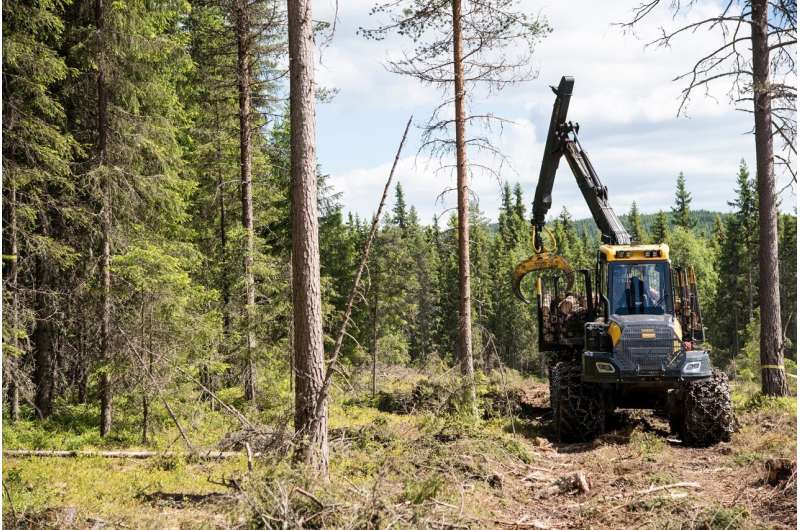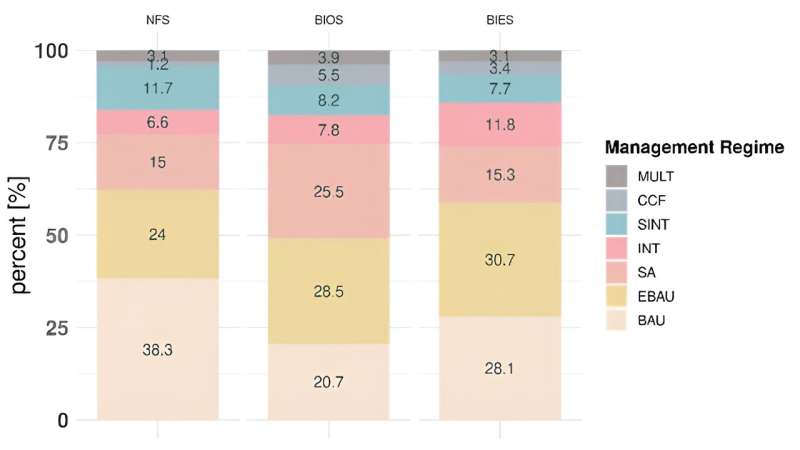This article has been reviewed according to Science X's editorial process and policies. Editors have highlighted the following attributes while ensuring the content's credibility:
fact-checked
proofread
New project examines how the expectations for forests can be met in more sustainable ways

Forests plays many vital roles: They provide a natural habitat for animals, plants and other organisms. They contribute to soil protection and water conservation, carbon storage and clean air.
Moreover, forests promote economic growth through providing essential goods and services for humans such as timber and food, in addition to a wide variety of products to replace fossil resources in a biobased economy. They are also popular places for outdoor recreation.
For forests to thrive, it is important that they are managed in a sustainable way balancing the various ecosystem service demands.
Most of these demands are mentioned in different national forest policies. However, such policies often focus on potentially conflicting societal needs, and are mostly developed in non-coordinated processes, both in Norway and other countries. This has created incoherences in design and implementation, leading to policies with conflicting targets.
In the international collaborative project MultiForest, scientists have looked at how expectations for forests can be met in a better way in four countries Sweden, Finland, Norway and Germany.
'Too many cooks'
There are currently many national and EU policies that guide forestry. To limit global warming, EU have launched strategies aimed at promoting the development of a renewable bioeconomy strategy. There are also biodiversity strategies and national forest strategies emphasizing different aspects of forest ecosystems.
"From a bioeconomy perspective the target is to increase harvest of wood biomass and increase wood fuel harvesting for bioenergy. But at the same time, there are policies that aim to halt the loss of biodiversity and safeguard ecosystem services from the forests, and for forests to contribute to climate change mitigation," explains Clara Antón Fernández, senior research scientist at NIBIO.
"So, in one policy, the target is to move from a fossil-based economy to a bio-based economy, in another it is to increase the protected areas, and yet in another one is to increase carbon uptake. Generally, there is a lack of coordination and coherence between these policies, and they rarely address the conflicts and links between these multiple demands," Dr. Antón highlights.
"Instead," she says, "they are designed from specific interests, creating policy incoherence that makes it impossible to reach policy targets and even threatens the sustainability of forest ecosystems."
Optimal balance
This challenge was the background for the European collaborative project MultiForest, where NIBIO is a partner. The project aim was to develop a solid basis for solving the socio-ecological land-use conflicts in forests that are caused by policy incoherence.
To find the ideal combination of forest management regimes, the scientists used a mathematical optimization approach, balancing the objectives and constrains in the policies in each country, and trying to find an optimal solution for the provision of different ecosystem services.
Marta Vargarechea, a researcher in the Division of Forest and Forest Resources at NIBIO, explains, "We have developed new approaches to evaluate the incoherence in the forest policies.
"This helps to balance different forest ecosystem service demands and offers a way to evaluate how far current policies are from an estimated maximum level of multifunctionality."

In Norway, the researchers used data from the Norwegian national forest inventory (NFI) and simulated the development of Norwegian forests under different management regimes. Next, they defined different forest policy scenarios based on three main policies: The National Forest policy (NFS), the Biodiversity policy (BIOS), and the Bioeconomy policy (BIES).
"Through what is known as multi-objective optimization, which refers to finding the optimal solution values of more than one desired goal, we have identified the combination of management regimes matching best with each policy scenario," Vargarechea says.
Business as usual in Norway
The results for all scenarios indicated that Norway will be able to satisfy wood demands of up to 17 million m3 in 2093. Yet, the future provision of ecosystem services by Norwegian forests will be decisively shaped by policy targets established at the national level.
"What we found was that the Bioeconomy policy and the National Forest policy resulted in very similar forest management programs in Norway, with a dominance of extensive management regimes. In the Biodiversity policy there was an increase of set aside areas and continuous cover forestry, which made it more compatible with biodiversity indicators. We also found multiple synergies and trade-offs between, likely influenced by the definition of the policy targets at the national scale," Vargarechea says.
She explains that the increase in set-aside areas in the Biodiversity policy could be offset by higher harvests elsewhere. This will concentrate forest management on specific land areas, increasing the impact on them. To reduce forest degradation, policy makers should develop incentives to motivate forest owners to adapt their management practices.
Norway has soft targets
However, according to Dr. Antón, the project observed that Norwegian policy targets were "softer," more qualitative than quantitative, than for example in Finland.
"In Norway the optimal combination of management regimes was not far from what we currently have. If we want to accomplish the targets in biodiversity, we need to increase the areas set aside. But at the same time, we also need to increase the intensive management regime to accomplish the targets for bioenergy and timber. Similarly, around the city, the forests have great recreational value, and management regimes such as continuous cover should be favored," she sums up.
"In Finland however, the optimal management solution for the Finnish forest policies requires considerable change in forest management to meet the stated policy objectives. In this case, Finland has very strong objectives, while the policies in Norway are a bit softer. When you have harder targets, it is easier to hold yourself accountable," Dr. Antón points out.
Limits
In Norway, there is also potential for increasing harvest for climate mitigation efforts. However, the achievement of these climate mitigation targets, represented by wood and biomass demands, will affect the provision of other ecosystems services and biodiversity conservation.
The scientists concluded that although forests play an important role in climate change mitigation, their contribution should not be overemphasized. "This can lead to conflicting expectations and negative long-term implications for other ecosystem services and biodiversity," comments Vargarechea.
"We need to recognize the limits of using forest resources for achieving mitigation targets and societal decarbonization."
Provided by Norwegian Institute of Bioeconomy Research




















